| Solar eclipse of June 21, 2020 | |
|---|---|
 Annularity as seen from Beigang, Yunlin, Taiwan Annularity as seen from Beigang, Yunlin, Taiwan | |
 Map Map | |
| Type of eclipse | |
| Nature | Annular |
| Gamma | 0.1209 |
| Magnitude | 0.994 |
| Maximum eclipse | |
| Duration | 38 s (0 min 38 s) |
| Coordinates | 30°30′N 79°42′E / 30.5°N 79.7°E / 30.5; 79.7 |
| Max. width of band | 21 km (13 mi) |
| Times (UTC) | |
| Greatest eclipse | 6:41:15 |
| References | |
| Saros | 137 (36 of 70) |
| Catalog # (SE5000) | 9553 |
An annular solar eclipse occurred at the Moon’s ascending node of orbit on Sunday, June 21, 2020, with a magnitude of 0.994. A solar eclipse occurs when the Moon passes between Earth and the Sun, thereby totally or partly obscuring the Sun for a viewer on Earth. An annular solar eclipse occurs when the Moon's apparent diameter is smaller than the Sun's, blocking most of the Sun's light and causing the Sun to look like an annulus (ring). An annular eclipse appears as a partial eclipse over a region of the Earth thousands of kilometres wide. Occurring about 6.2 days after apogee (on June 15, 2020, at 1:55 UTC), the Moon's apparent diameter was smaller.
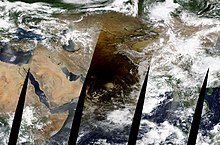
Path
The path of this annular eclipse passed through parts of the Democratic Republic of the Congo, South Sudan, Ethiopia, and Eritrea in Africa; the southern Arabian Peninsula, including Yemen, Oman, and southern Saudi Arabia; parts of South Asia and the Himalayas, including southern Pakistan and northern India; and parts of East Asia, including South China and Taiwan. A partial eclipse was visible throughout much of the rest of Africa, Southeast Europe, most of Asia, and in New Guinea and northern Australia just before sunset. In Europe, the partial eclipse was visible to places southeast of the line passing through parts of Italy, Hungary, Ukraine, and southwestern Russia.
 Animated path of the eclipse
Animated path of the eclipse Animation of images from Himawari 8 showing the Moon's shadow moving across the Earth.
Animation of images from Himawari 8 showing the Moon's shadow moving across the Earth.
Gallery
-
 Partial from Addis Ababa, Ethiopia, 4:53 UTC
Partial from Addis Ababa, Ethiopia, 4:53 UTC
-
 Partial from Sana'a, Yemen, 5:09 UTC
Partial from Sana'a, Yemen, 5:09 UTC
-
 Partial from Riyadh, Saudi Arabia, 5:11 UTC
Partial from Riyadh, Saudi Arabia, 5:11 UTC
-
 Eclipse progression from Tehran, Iran
Eclipse progression from Tehran, Iran
-
 Partial from Gyumri, Armenia, 5:45 UTC
Partial from Gyumri, Armenia, 5:45 UTC
-
 Partial from Colombo, Sri Lanka, 5:48 UTC
Partial from Colombo, Sri Lanka, 5:48 UTC
-
 Partial from Lahore, Pakistan, 6:49 UTC
Partial from Lahore, Pakistan, 6:49 UTC
-
 Partial from Kathmandu, Nepal, 6:51 UTC
Partial from Kathmandu, Nepal, 6:51 UTC
-
 Partial from Irkutsk, Russia, ~7:22 UTC
Partial from Irkutsk, Russia, ~7:22 UTC
-
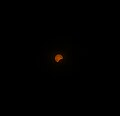 Partial from Bacoor, Philippines, 7:31 UTC
Partial from Bacoor, Philippines, 7:31 UTC
-
 Partial from Kolkata, India, 7:42 UTC
Partial from Kolkata, India, 7:42 UTC
-
 Telescopic view from Chennai, India
Telescopic view from Chennai, India
-
 Partial from Beijing, China, 7:51 UTC
Partial from Beijing, China, 7:51 UTC
-
 Partial from Jinan, China, 7:56 UTC
Partial from Jinan, China, 7:56 UTC
-
 Partial from Tai'an, China, 7:57 UTC
Partial from Tai'an, China, 7:57 UTC
-
 Partial from Gandara, Samar, Philippines, 8:01 UTC
Partial from Gandara, Samar, Philippines, 8:01 UTC
-
 Partial from Kaohsiung, Taiwan, 8:05 UTC
Partial from Kaohsiung, Taiwan, 8:05 UTC
-
 Partial from Yau Tong, Hong Kong, 8:08 UTC
Partial from Yau Tong, Hong Kong, 8:08 UTC
-
 Partial from Taichung, Taiwan, 8:09 UTC
Partial from Taichung, Taiwan, 8:09 UTC
-
 Partial from Pangkalpinang, Indonesia, 8:10 UTC
Partial from Pangkalpinang, Indonesia, 8:10 UTC
-
 Xiamen, China, 8:11 UTC
Xiamen, China, 8:11 UTC
-
 Time-lapse image of the eclipse in Xiamen, China
Time-lapse image of the eclipse in Xiamen, China
-
 Partial from Fukuoka, Japan, 8:12 UTC
Partial from Fukuoka, Japan, 8:12 UTC
-
 Chiayi, Taiwan, 8:13 UTC
Chiayi, Taiwan, 8:13 UTC
-
 Partial from Hsinchu, Taiwan, 8:18 UTC
Partial from Hsinchu, Taiwan, 8:18 UTC
-
 Partial from Surabaya, Indonesia, 8:22 UTC
Partial from Surabaya, Indonesia, 8:22 UTC
-
 Partial from San Jose del Monte, Philippines, 8:23 UTC
Partial from San Jose del Monte, Philippines, 8:23 UTC
-
 Eclipse progression from Oria, Italy
Eclipse progression from Oria, Italy
-
 The Moon's antumbra, as seen from the ISS
The Moon's antumbra, as seen from the ISS
-
 Eclipse progression at the annular stage, seen from Minxiong, Chiayi County, Taiwan
Eclipse progression at the annular stage, seen from Minxiong, Chiayi County, Taiwan
Eclipse details
Shown below are two tables displaying details about this particular solar eclipse. The first table outlines times at which the moon's penumbra or umbra attains the specific parameter, and the second table describes various other parameters pertaining to this eclipse.
| Event | Time (UTC) |
|---|---|
| First Penumbral External Contact | 2020 June 21 at 03:47:09.9 UTC |
| First Umbral External Contact | 2020 June 21 at 04:48:54.2 UTC |
| First Central Line | 2020 June 21 at 04:49:37.4 UTC |
| Greatest Duration | 2020 June 21 at 04:49:37.4 UTC |
| First Umbral Internal Contact | 2020 June 21 at 04:50:20.7 UTC |
| First Penumbral Internal Contact | 2020 June 21 at 05:52:48.7 UTC |
| Greatest Eclipse | 2020 June 21 at 06:41:15.4 UTC |
| Equatorial Conjunction | 2020 June 21 at 06:42:34.5 UTC |
| Ecliptic Conjunction | 2020 June 21 at 06:42:36.6 UTC |
| Last Penumbral Internal Contact | 2020 June 21 at 07:29:41.2 UTC |
| Last Umbral Internal Contact | 2020 June 21 at 08:32:11.3 UTC |
| Last Central Line | 2020 June 21 at 08:32:51.7 UTC |
| Last Umbral External Contact | 2020 June 21 at 08:33:32.0 UTC |
| Last Penumbral External Contact | 2020 June 21 at 09:35:13.9 UTC |
| Parameter | Value |
|---|---|
| Eclipse Magnitude | 0.99401 |
| Eclipse Obscuration | 0.98806 |
| Gamma | 0.12090 |
| Sun Right Ascension | 06h01m33.0s |
| Sun Declination | +23°26'09.7" |
| Sun Semi-Diameter | 15'44.2" |
| Sun Equatorial Horizontal Parallax | 08.7" |
| Moon Right Ascension | 06h01m30.2s |
| Moon Declination | +23°32'56.7" |
| Moon Semi-Diameter | 15'24.0" |
| Moon Equatorial Horizontal Parallax | 0°56'31.1" |
| ΔT | 70.0 s |
Eclipse season
See also: Eclipse cycleThis eclipse is part of an eclipse season, a period, roughly every six months, when eclipses occur. Only two (or occasionally three) eclipse seasons occur each year, and each season lasts about 35 days and repeats just short of six months (173 days) later; thus two full eclipse seasons always occur each year. Either two or three eclipses happen each eclipse season. In the sequence below, each eclipse is separated by a fortnight. The first and last eclipse in this sequence is separated by one synodic month.
| June 5 Descending node (full moon) |
June 21 Ascending node (new moon) |
July 5 Descending node (full moon) |
|---|---|---|
 |
 |

|
| Penumbral lunar eclipse Lunar Saros 111 |
Annular solar eclipse Solar Saros 137 |
Penumbral lunar eclipse Lunar Saros 149 |
Related eclipses
Eclipses in 2020
- A penumbral lunar eclipse on January 10.
- A penumbral lunar eclipse on June 5.
- An annular solar eclipse on June 21.
- A penumbral lunar eclipse on July 5.
- A penumbral lunar eclipse on November 30.
- A total solar eclipse on December 14.
Metonic
- Preceded by: Solar eclipse of September 1, 2016
- Followed by: Solar eclipse of April 8, 2024
Tzolkinex
- Preceded by: Solar eclipse of May 10, 2013
- Followed by: Solar eclipse of August 2, 2027
Half-Saros
- Preceded by: Lunar eclipse of June 15, 2011
- Followed by: Lunar eclipse of June 26, 2029
Tritos
- Preceded by: Solar eclipse of July 22, 2009
- Followed by: Solar eclipse of May 21, 2031
Solar Saros 137
- Preceded by: Solar eclipse of June 10, 2002
- Followed by: Solar eclipse of July 2, 2038
Inex
- Preceded by: Solar eclipse of July 11, 1991
- Followed by: Solar eclipse of May 31, 2049
Triad
- Preceded by: Solar eclipse of August 21, 1933
- Followed by: Solar eclipse of April 23, 2107
Solar eclipses of 2018–2021
This eclipse is a member of a semester series. An eclipse in a semester series of solar eclipses repeats approximately every 177 days and 4 hours (a semester) at alternating nodes of the Moon's orbit.
The partial solar eclipses on February 15, 2018 and August 11, 2018 occur in the previous lunar year eclipse set.
| Solar eclipse series sets from 2018 to 2021 | ||||||
|---|---|---|---|---|---|---|
| Ascending node | Descending node | |||||
| Saros | Map | Gamma | Saros | Map | Gamma | |
117 Partial in Melbourne, Australia |
July 13, 2018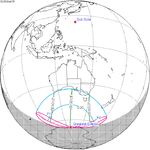 Partial |
−1.35423 | 122 Partial in Nakhodka, Russia |
January 6, 2019 Partial |
1.14174 | |
127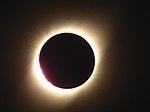 Totality in La Serena, Chile |
July 2, 2019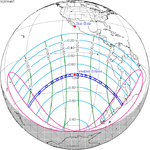 Total |
−0.64656 | 132 Annularity in Jaffna, Sri Lanka |
December 26, 2019 Annular |
0.41351 | |
137 Annularity in Beigang, Yunlin, Taiwan |
June 21, 2020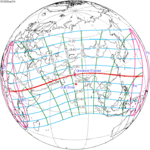 Annular |
0.12090 | 142 Totality in Gorbea, Chile |
December 14, 2020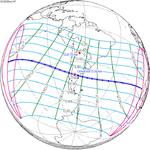 Total |
−0.29394 | |
147 Partial in Halifax, Canada |
June 10, 2021 Annular |
0.91516 | 152 From HMS Protector off South Georgia |
December 4, 2021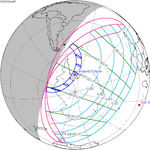 Total |
−0.95261 | |
Saros 137
This eclipse is a part of Saros series 137, repeating every 18 years, 11 days, and containing 70 events. The series started with a partial solar eclipse on May 25, 1389. It contains total eclipses from August 20, 1533 through December 6, 1695; the first set of hybrid eclipses from December 17, 1713 through February 11, 1804; the first set of annular eclipses from February 21, 1822 through March 25, 1876; the second set of hybrid eclipses from April 6, 1894 through April 28, 1930; and the second set of annular eclipses from May 9, 1948 through April 13, 2507. The series ends at member 70 as a partial eclipse on June 28, 2633. Its eclipses are tabulated in three columns; every third eclipse in the same column is one exeligmos apart, so they all cast shadows over approximately the same parts of the Earth.
The longest duration of totality was produced by member 11 at 2 minutes, 55 seconds on September 10, 1569, and the longest duration of annularity will be produced by member 59 at 7 minutes, 5 seconds on February 28, 2435. All eclipses in this series occur at the Moon’s ascending node of orbit.
| Series members 24–46 occur between 1801 and 2200: | ||
|---|---|---|
| 24 | 25 | 26 |
 February 11, 1804 |
 February 21, 1822 |
 March 4, 1840 |
| 27 | 28 | 29 |
 March 15, 1858 |
 March 25, 1876 |
 April 6, 1894 |
| 30 | 31 | 32 |
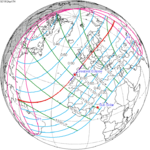 April 17, 1912 |
 April 28, 1930 |
 May 9, 1948 |
| 33 | 34 | 35 |
 May 20, 1966 |
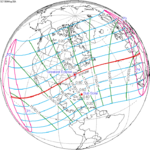 May 30, 1984 |
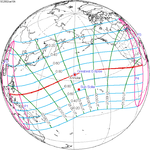 June 10, 2002 |
| 36 | 37 | 38 |
 June 21, 2020 |
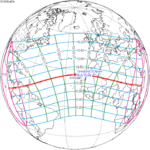 July 2, 2038 |
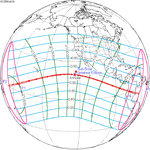 July 12, 2056 |
| 39 | 40 | 41 |
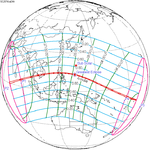 July 24, 2074 |
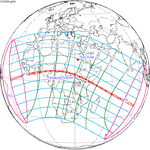 August 3, 2092 |
 August 15, 2110 |
| 42 | 43 | 44 |
 August 25, 2128 |
 September 6, 2146 |
 September 16, 2164 |
| 45 | 46 | |
 September 27, 2182 |
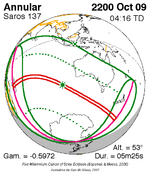 October 9, 2200 | |
Metonic series
The metonic series repeats eclipses every 19 years (6939.69 days), lasting about 5 cycles. Eclipses occur in nearly the same calendar date. In addition, the octon subseries repeats 1/5 of that or every 3.8 years (1387.94 days). All eclipses in this table occur at the Moon's ascending node.
| 21 eclipse events between June 21, 1982 and June 21, 2058 | ||||
|---|---|---|---|---|
| June 21 | April 8–9 | January 26 | November 13–14 | September 1–2 |
| 117 | 119 | 121 | 123 | 125 |
 June 21, 1982 |
 April 9, 1986 |
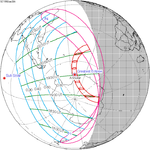 January 26, 1990 |
 November 13, 1993 |
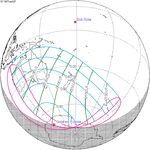 September 2, 1997 |
| 127 | 129 | 131 | 133 | 135 |
 June 21, 2001 |
 April 8, 2005 |
 January 26, 2009 |
 November 13, 2012 |
 September 1, 2016 |
| 137 | 139 | 141 | 143 | 145 |
 June 21, 2020 |
 April 8, 2024 |
 January 26, 2028 |
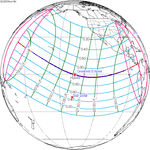 November 14, 2031 |
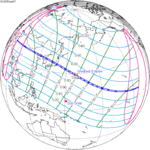 September 2, 2035 |
| 147 | 149 | 151 | 153 | 155 |
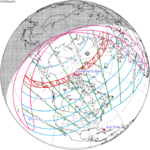 June 21, 2039 |
 April 9, 2043 |
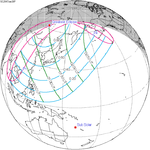 January 26, 2047 |
 November 14, 2050 |
 September 2, 2054 |
| 157 | ||||
 June 21, 2058 | ||||
Tritos series
This eclipse is a part of a tritos cycle, repeating at alternating nodes every 135 synodic months (≈ 3986.63 days, or 11 years minus 1 month). Their appearance and longitude are irregular due to a lack of synchronization with the anomalistic month (period of perigee), but groupings of 3 tritos cycles (≈ 33 years minus 3 months) come close (≈ 434.044 anomalistic months), so eclipses are similar in these groupings.
| Series members between 1801 and 2200 | ||||
|---|---|---|---|---|
 March 4, 1802 (Saros 117) |
 February 1, 1813 (Saros 118) |
 January 1, 1824 (Saros 119) |
 November 30, 1834 (Saros 120) |
 October 30, 1845 (Saros 121) |
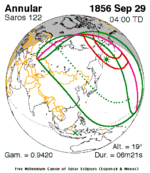 September 29, 1856 (Saros 122) |
 August 29, 1867 (Saros 123) |
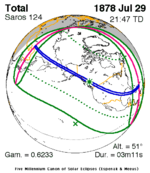 July 29, 1878 (Saros 124) |
 June 28, 1889 (Saros 125) |
 May 28, 1900 (Saros 126) |
 April 28, 1911 (Saros 127) |
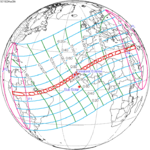 March 28, 1922 (Saros 128) |
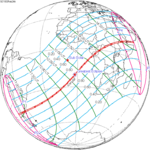 February 24, 1933 (Saros 129) |
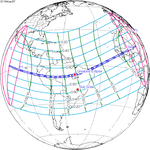 January 25, 1944 (Saros 130) |
 December 25, 1954 (Saros 131) |
 November 23, 1965 (Saros 132) |
 October 23, 1976 (Saros 133) |
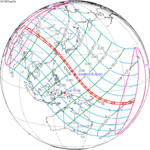 September 23, 1987 (Saros 134) |
 August 22, 1998 (Saros 135) |
 July 22, 2009 (Saros 136) |
 June 21, 2020 (Saros 137) |
 May 21, 2031 (Saros 138) |
 April 20, 2042 (Saros 139) |
 March 20, 2053 (Saros 140) |
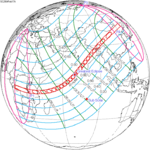 February 17, 2064 (Saros 141) |
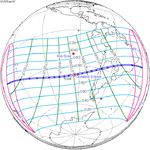 January 16, 2075 (Saros 142) |
 December 16, 2085 (Saros 143) |
 November 15, 2096 (Saros 144) |
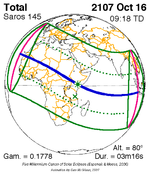 October 16, 2107 (Saros 145) |
 September 15, 2118 (Saros 146) |
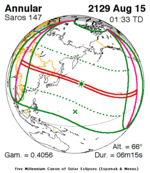 August 15, 2129 (Saros 147) |
 July 14, 2140 (Saros 148) |
 June 14, 2151 (Saros 149) |
 May 14, 2162 (Saros 150) |
 April 12, 2173 (Saros 151) |
 March 12, 2184 (Saros 152) |
 February 10, 2195 (Saros 153) | |||
Inex series
This eclipse is a part of the long period inex cycle, repeating at alternating nodes, every 358 synodic months (≈ 10,571.95 days, or 29 years minus 20 days). Their appearance and longitude are irregular due to a lack of synchronization with the anomalistic month (period of perigee). However, groupings of 3 inex cycles (≈ 87 years minus 2 months) comes close (≈ 1,151.02 anomalistic months), so eclipses are similar in these groupings.
| Series members between 1801 and 2200 | ||
|---|---|---|
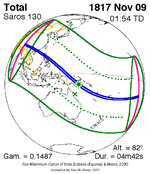 November 9, 1817 (Saros 130) |
 October 20, 1846 (Saros 131) |
 September 29, 1875 (Saros 132) |
 September 9, 1904 (Saros 133) |
 August 21, 1933 (Saros 134) |
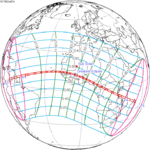 July 31, 1962 (Saros 135) |
 July 11, 1991 (Saros 136) |
 June 21, 2020 (Saros 137) |
 May 31, 2049 (Saros 138) |
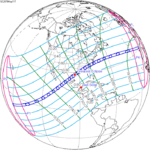 May 11, 2078 (Saros 139) |
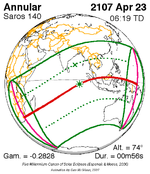 April 23, 2107 (Saros 140) |
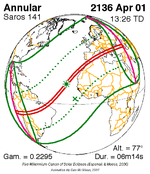 April 1, 2136 (Saros 141) |
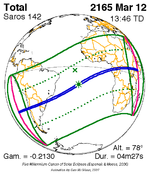 March 12, 2165 (Saros 142) |
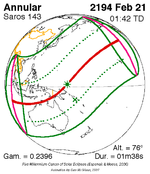 February 21, 2194 (Saros 143) |
|
References
- "June 21, 2020 Annular Solar Eclipse". timeanddate. Retrieved 12 August 2024.
- Rao, Joe (June 20, 2020). "'Ring of fire' solar eclipse 2020: Here's how it works (and what to expect)". Space.com.
- Elassar, Alaa (June 21, 2020). "Astronauts are spending Father's Day in space watching the solar eclipse". CNN.
- Taylor, Alan. "Photos: A Solstice 'Ring of Fire' Solar Eclipse - The Atlantic". www.theatlantic.com.
- "Cloudy skies block view of annular solar eclipse in Hyderabad". June 22, 2020 – via The Economic Times - The Times of India.
- "Annular solar eclipse prompts excitement across Taiwan". Taiwan News. June 21, 2020.
- "Annular solar eclipse of 2020 Jun 21". Retrieved 2021-06-22.
- "Moon Distances for London, United Kingdom, England". timeanddate. Retrieved 12 August 2024.
- ^ "Annular Solar Eclipse on June 21, 2020". www.timeanddate.com. Retrieved 2019-12-26.
- "Annular Solar Eclipse of 2020 Jun 21". EclipseWise.com. Retrieved 12 August 2024.
- van Gent, R.H. "Solar- and Lunar-Eclipse Predictions from Antiquity to the Present". A Catalogue of Eclipse Cycles. Utrecht University. Retrieved 6 October 2018.
- "NASA - Catalog of Solar Eclipses of Saros 137". eclipse.gsfc.nasa.gov.
External links
- Earth visibility chart and eclipse statistics Eclipse Predictions by Fred Espenak, NASA/GSFC
- solar-eclipse.de: The annular solar eclipse of 06/21/2020
- Annular Solar Eclipse 2020
- Chinese satellite images (via twitter)


